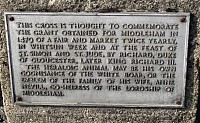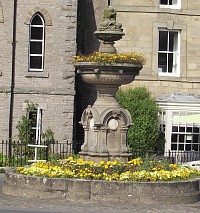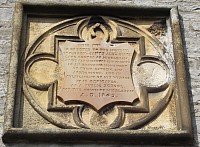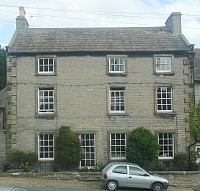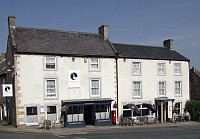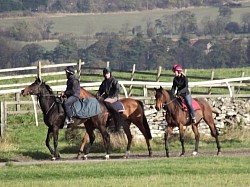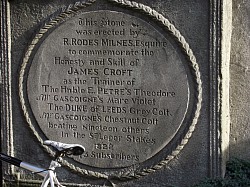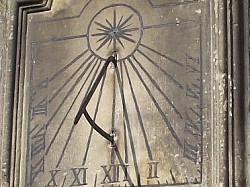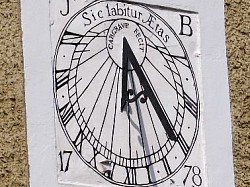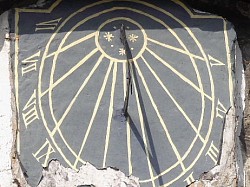A Medley of Middleham Tales
The tenants of Middleham had grazing rights on Middleham Moor. In the 1720s Francis Hogg was the herd of the moor, and would have known every animal and who it belonged to. Disputes were frequent, and a certain William Smith of Cotescue claimed that he had grazing rights even though he did not live in Middleham, and Richard Dixon impounded 27 of his sheep. Middleham folk also had grazing rights on the Busks to the north of the town, which was used mostly for horses.
A market and fair were granted in 1389, the market was on Mondays and the fair on the Feast of St Alkelda. Richard Duke of Gloucester granted additional fairs as recorded on the plaque. The market gradually fell into decline after Leyburn was granted a charter for a market. The good people of Middleham objected to this as it was too near their own market. By the 1680s they employed a lawyer to go to the King's Court to fight their case, saying that Leyburn market would damage their trade, but by the early 18th century Leyburn market was established and Middleham market dwindled and dwindled until it ceased in the 19th century. Middleham has two market places, and two market crosses, this plaque is on the Swine Cross.
The Victoria Fountain was built by public subscription in 1887 to celebrate Queen Victoria's Jubilee.The town also decided to have a party, meetings were held with most of the inhabitants. Some wanted to roast an ox, and have plum pudding and beer in the Castle, some wanted a sit down tea and NO DANCING. The organising committee broke up and subscriptions were returned, another meeting was held by Mr Topham at Castle Hill, and a new subscription was started to provide a substantial "meat tea" for all the inhabitants including the children, which is what they did. We hope they enjoyed their tea, we still enjoy the Victoria Fountain.
The school in Middleham was called the Birch Memorial School after the Reverend James Alexander Birch. In 1857 he married Martha Elizabeth Topham, daughter of Lupton Topham, solicitor and Clerk of the Peace for the North Riding. They had two children, and then the Rev James Alexander died on the 26th December 1866, he was buried at Coverham, his monument records that he was born at Battle in Sussex. The town then raised funds in his memory and the site was given by the Wood family who were the Lords of the Manor. £600 was raised by subscription and the foundation stone was laid in May 1869 accompanied by Redmire Brass Band. The school finally opened in May 1871, and is still a fine building, but was it big enough ? In 1871 the population of Middleham was 909 people and accommodation was needed for 156 children, and this school had space for 106.
Glasgow House was named after Lord Glasgow, 1792 - 1869, his family were called Boyle of Kelburn Castle in Ayreshire, and he was first known as being very temperamental. There are stables behind this house, still used as a training establishment. One of Lord Glasgow's trainers was James Croft and there is a plaque to his memory in the yard. In 1822 Croft trained the first four horses who crossed the line as 1st, 2nd, 3rd and 4th in the St Leger.
Middleham had several inns and was well served with coaches before the age of the railways. This is the White Swan which had been a coaching Inn. In 1792 John Byng, Viscount Torrington toured the north of England and recorded his impressions of the White Swan. He ordered trout for his supper and then told his host how to cook it, he preferred his trout boiled and not fried in butter with fennel and parsley ! But he also supped on ham, cold beef, cold fowl and gooseberry pie.
In 1805 Charles Fothergill recorded his tour around Yorkshire and also stayed at the White Swan where he recorded that he took advantage of more than the victuals "I put up at the White Swan in the Market place, Mrs Burton's..." where he was bewitched by the charms of the maid servant.
Training race horses is the most conspicuous part of the local economy and there are stables all around the town and Middleham Moor. Horse racing was held on Middleham Moor for many years. When the Wood family purchased the Manor of Middleham in 1662 their accounts show that they paid money for the prizes. Races were held until 1873. In 1713 the London Gazette reported
Upon the last Wednesday in August a Plate of about £30 value will be run for upon Middleham Moor in Yorkshire by any Horse, Mare or Gelding, under 6 years old carrying 10 stone weight etc according to the articles usually observed.
In 1735 the Newcastle Courant advertised a race to be run for on the New Course on Middleham Moor.
The stables employed many young stable boys and jockeys and attracted the patronage of the nobility. The censuses list young boys, sometimes only ten years old, from all parts of the country. In 1851 there was 117 people employed in race horse training, and of these only 41 were locals. Horse Racing also attracted touts and reporters from the racing press. In the 1851 census there is a certain character called John Valentine who described himself as "Tout and Spy on racehorses under training employed by Gamblers". By 1881 Middleham had its own reporters or Sporting Correspondents. John Dobbie had come to Middleham as a groom in the racing stables, then he took over the Black Swan Inn in 1871 and by 1878 called himself a Turf Reporter. Over the second half of the nineteenth century the stables went into decline and the numbers employed fell, but it is still an important aspect of life in Middleham and it is a wonderful sight to see the horses training on the moor.
When you hear the clatter of all the horses' hooves on the cobbles as they are taken out of their stables to train on the moor it seems as if time has stood still in Middleham.

